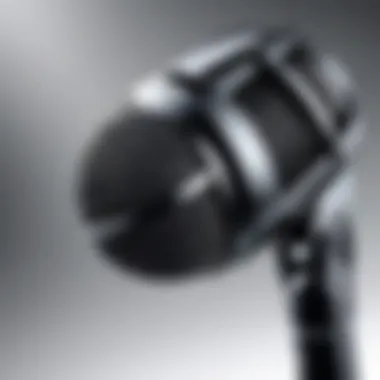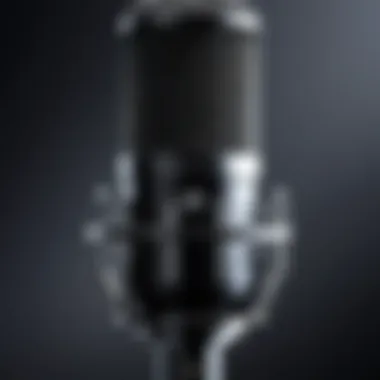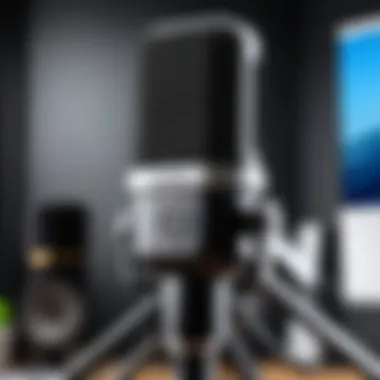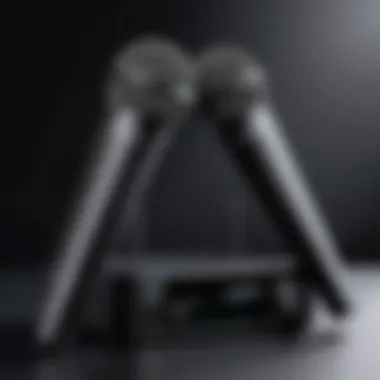Top Microphones for Singing: A Comprehensive Guide


Intro
Choosing the right microphone for singing is a pivotal decision for both amateur vocalists and seasoned professionals. With a plethora of options available, it can be overwhelming to determine which microphone best fits your needs. This guide will help you navigate through the intricacies of various microphone types, such as dynamic and condenser microphones.
In this article, we will provide clarity on key specifications, evaluate performance through comparisons, and discuss unique features that set each microphone apart. Whether you're aiming for studio-quality recordings or enhancing your live performances, our comprehensive analysis will support your quest for the ideal audio companion.
Understanding these aspects not only aids in improving sound quality but also ensures that your investment yields long-lasting benefits.
Preface to Singing Microphones
Choosing the right microphone for singing is not just a matter of preference. It is crucial for capturing the essence of a voice in a way that resonates with listeners. The mic you select can drastically influence the clarity, warmth, and overall quality of sound produced during performances or recordings. Understanding this importance leads to informed choices, affecting everything from gig setups to studio recordings.
Importance of Choosing the Right Microphone
Selecting the correct microphone can make a significant difference. A good mic can enhance a singer's vocal abilities, while a poor choice may detract from them. Factors like sound output, acoustic characteristics, and microphone sensitivity must be examined carefully. A wide frequency response gives the singer a fuller sound, making it crucial for live performances.
Without proper equipment, even the most talented singers can sound flat. Therefore, this topic serves as a fundamental building block for understanding audio quality in singing. It creates a base for evaluating equipment and its technological features.
Different Microphone Types Explained
Various microphone types are available, each with unique strengths and weaknesses. Understanding these differences is integral to selecting the right one. Here, we outline the three main types of microphones: dynamic, condenser, and ribbon.
Dynamic Microphones
Dynamic microphones are well-known for their durability. They are often used in live performances due to their capacity to handle high sound pressure levels without distortion. The key characteristic of dynamic mics is their moving-coil diaphragm, which converts sound into electrical energy. This makes them suitable for singing in loud environments.
These mics typically have a cardioid polar pattern, focusing on sound from the front while minimizing pickup from the sides and rear. This feature reduces background noise and feedback, making them a beneficial choice for stage performances.
Despite their advantages, dynamic mics tend to have a narrower frequency response than condenser mics. This can limit their ability to capture high-frequency sounds accurately, making them less ideal for some vocal styles.
Condenser Microphones
Condenser microphones excel in sensitivity, making them perfect for capturing nuanced vocal details in controlled environments. Their design usually includes a thin diaphragm placed near a backplate, creating a capacitive element that responds to sound waves.
The key feature of condenser mics is their wide frequency response, allowing for rich and clear audio. They thrive in studio settings, making them a popular choice for recording professional vocals. They pick up subtleties in voice that dynamic mics may miss.
However, these mics are more sensitive to background noise and require phantom power to operate. This can limit their utility in live scenarios where unpredictable noise is present.
Ribbon Microphones
Ribbon microphones are often regarded for their vintage sound qualities. They utilize a thin metal ribbon suspended in a magnetic field to generate audio signals. This feature gives them a unique tonal quality that can add warmth to vocal recordings.
The hallmark of ribbon mics is their figure-8 polar pattern, allowing for sound pickup from the front and rear while rejecting sounds from the sides. This makes them ideal for specific recording techniques, such as capturing duets or ambient sounds in a live setting.
On the downside, ribbon mics are more delicate than their dynamic and condenser counterparts. Care should be taken when using them, as excessive sound pressure can damage the ribbon. Their more specialized application limits their general use in performance settings.
Choosing the right mic requires understanding these differences. The type of microphone profoundly impacts sound quality and performance outcomes.
Key Factors in Microphone Selection
Selecting the right microphone involves understanding several key factors. Each factor impacts sound quality and overall performance, enabling users to make informed choices. If you want clarity and precision in sound reproduction, it is vital that you consider these elements carefully. This section will cover critical aspects of microphone selection to aid your decision-making process.
Frequency Response
Frequency response refers to the range of sound frequencies a microphone can capture effectively. This range is usually represented as a spectrum, from low to high frequencies. A microphone with a broader frequency response can handle vocals better by capturing all tonal qualities without distortion. For singing, you want a microphone that adequately reproduces the human voice, typically between 85 Hz and 15 kHz. In addition, knowing the frequency response helps match the microphone to the environment or genre you are performing in.
Polar Patterns
Understanding polar patterns is crucial when selecting a microphone. These patterns describe how a microphone picks up sound from various directions. Common polar patterns include:
Cardioid
Cardioid microphones are designed to pick up sound primarily from the front. This makes them a popular choice for live performances. The key characteristic is that they reduce ambient noise, which is beneficial in loud environments. Moreover, this directional sensitivity minimizes feedback issues. Cardioid microphones focus on the vocalist and ignore sounds from the sides and rear. The disadvantage, however, is that they can struggle with sound sources positioned directly behind them.
Omnidirectional
Omnidirectional microphones capture sound equally from all directions. This feature is advantageous when you want to record a group of singers or instruments within a space. The key characteristic of an omnidirectional microphone is its ability to gather ambient sound, creating a natural and spacious ambience in recordings. Nevertheless, this also makes them vulnerable to background noise, which is a significant consideration in a noisy environment.
Figure-8


Figure-8 microphones are sensitive to sounds directly in front and behind but reject sound from the sides. This polar pattern is particularly effective for duet recordings or capturing sound from two sources positioned on opposite sides. The unique feature of figure-8 microphones is their ability to create a focused sound while maintaining some ambient quality. However, this can result in unwanted noise if not managed properly.
Sensitivity and SPL Handling
Sensitivity relates to how well a microphone converts sound pressure into electrical signals. A highly sensitive microphone can pick up quieter sounds and more subtle vocal nuances. This feature is important for vocalists whose performance ranges vary. Sound Pressure Level (SPL) handling depicts the maximum sound pressure a microphone can handle without distortion. A microphone with good SPL handling is ideal for powerful vocal performances or instruments like drums. When considering both factors, assess your specific needs carefully, as choosing a microphone with too high sensitivity may introduce unwanted noise.
Connectivity Options
Another important factor is connectivity options. Different microphones come with various connection types, such as XLR, USB, and even wireless options. XLR connections are standard for professional settings, ensuring high-quality audio transmission. USB microphones are suitable for home recording setups, providing an easy plug-and-play solution. Wireless options offer flexibility for performances on stage. Choose the option that best fits your setup to ensure compatibility and convenience.
Top Microphones for Singing
Selecting a microphone for singing is a fundamental choice for any vocalist or audio engineer. The microphone directly influences sound quality, which can significantly affect performance and recording outcomes. This guide extensively analyzes several microphones to help users make informed decisions, based on unique needs and technical specifications.
When evaluating different microphones, consider factors like sound clarity, durability, and intended use case. Additionally, understanding the microphone's specifications will assist singers in harnessing their vocal potential effectively.
Shure SM58
Overview
The Shure SM58 is revered in the music industry for its robust construction and reliability. Known for delivering clear vocal reproduction, it has a frequency response tailored for singing. The cardioid pickup pattern minimizes background noise, ensuring that the singer's voice takes center stage.
The SM58's ability to handle high sound pressure levels makes it an excellent choice for live performances. Its dynamic design also contributes to exceptional durability and a long lifespan, making it a wise investment.
Pros and Cons
Among its advantages, the Shure SM58 offers excellent feedback rejection and works well in diverse environments. However, its weight may be slightly more than some other options, which could cause fatigue during extended use. Despite this, many professionals prefer it due to its uncomplicated setup and consistent performance.
Ideal Use Cases
The SM58 is particularly effective for live vocals, especially in venues where background noise is a concern. It is also suitable for studio use, providing a good balance for both rock and pop vocals. Its versatility makes it a staple for many touring musicians.
Audio-Technica AT2020
Overview
The Audio-Technica AT2020 stands out as a versatile condenser microphone with an exceptional frequency response. It has a self-noise level below many competitive models, ensuring pristine audio capture. That makes it ideal for capturing the nuances of the human voice in various settings.
Its cardioid polar pattern effectively rejects off-axis noise, which helps keep recordings clear. The microphone's build quality is robust, which adds to its longevity.
Pros and Cons
Pros of the AT2020 include its affordability and sound quality, which rivals higher-priced models. However, it's less effective in high-SPL environments compared to some dynamic microphones. Users should keep this in mind when deciding on the application.
Ideal Use Cases
This microphone is excellent for home studio setups and live vocals in lower volume situations. It is also appreciated for recording acoustic guitar and voiceovers in a studio environment, where clarity is essential.
Rode NT1-A
Overview
The Rode NT1-A is frequently praised for its low self-noise and high sensitivity. With a wide frequency response, it offers a detailed and accurate representation of vocals and acoustic instruments alike. As a condenser microphone, it captures subtle tonal qualities that many performers seek.
Its sleek design and exceptional shock mount help minimize unwanted vibrations, providing a clean sound.
Pros and Cons
The NT1-A excels in quiet settings and is suitable for both solo and ensemble vocals. However, it may pick up excessive background noise in louder environments. Awareness of surrounding factors during recording is crucial.
Ideal Use Cases
Ideal for studio applications, the NT1-A is perfect for vocals, podcasting, and recording acoustic instruments. It provides rich audio quality, making it a popular choice among amateur and professional recordings alike.
SENNHEISER E835
Overview
The SENNHEISER E835 is recognized for its quality sound reproduction and affordability. It features a cardioid pickup pattern that effectively isolates vocals from ambient sounds. This microphone is built for durability, with a metal housing designed to withstand challenging performance environments.


Its frequency response is tailored for vocal clarity, offering a warm and natural tonal color.
Pros and Cons
One of the E835's most notable advantages is its versatility across different genres. However, some users report a slightly heavier sonic footprint, which may not suit all vocalists.
Ideal Use Cases
Best for stage performances, the E835 shines in both live and studio settings. It is popular among singers due to its adaptability, making it suitable for various musical styles and performance scenarios.
AKG C214
Overview
The AKG C214 embraces a studio-grade performance with its cardioid polar pattern and wide frequency range. This condenser microphone captures nuances with remarkable precision, making it a favorite for vocalists seeking studio-quality recordings. Its robust build ensures durability over time, making it a sound investment for aspiring artists.
Pros and Cons
Advantages include clear sound reproduction and a lower self-noise level, which many users favor. Nonetheless, its price point is higher compared to entry-level microphones, which might not be suitable for every budget.
Ideal Use Cases
The C214 is particularly effective in studio environments, where its detailed sound quality can flourish. It is often used for vocals, acoustic instruments, and even drum overheads, showcasing its versatile application.
Beyerdynamic M88 TG
Overview
The Beyerdynamic M88 TG is a dynamic microphone designed specifically for vocals. Known for its high sensitivity and superb transient response, it captures sounds with remarkable depth. The M88 is equally efficient in live and studio settings due to its cardioid design that offers excellent feedback rejection.
Pros and Cons
One of the notable advantages is its frequency response, which highlights low frequencies. However, it might not be as effective as others in extremely quiet environments, as it can introduce some noise from handling.
Ideal Use Cases
Ideal for live performances, the M88 is also used in studios for vocal takes and instruments. Its strong construction aids in withstanding rigorous multi-use situations.
Neumann TLM
Overview
The Neumann TLM 102 is a professional-grade condenser microphone known for its compact design and exceptional sound. It offers impressive clarity, making it suitable for recording singing in high-end studio setups. Its frequency response captures a wide range of vocal textures, ensuring expressive tonal reproduction.
Pros and Cons
The TLM 102 provides remarkable sound quality for the price, often regarded as a go-to microphone for those seeking quality. However, its premium cost might be a barrier for beginners.
Ideal Use Cases
Best suited for vocal recordings, the TLM 102 is commonly found in professional studios. It works well for both solo and group vocal performances, thus appealing to various artists.
Shure KSM8
Overview
The Shure KSM8 is an innovative dynamic microphone characterized by its dual-diaphragm design. This mic is known for low handling noise and excellent sound reproduction, making it one of the standout options for live vocals. It also offers a clean and accurate sound profile that upcoming artists may find attractive.
Pros and Cons
Advantages include its broad frequency response and feedback rejection. Conversely, its unique design may come with a higher price point, considerably more compared to typical dynamic mics.
Ideal Use Cases
Ideal for live performances, the KSM8 shines in environments where clarity and sound isolation are paramount. Its adaptability also allows it to perform well in studio setups, making it a versatile option.
Telefunken M80
Overview


The Telefunken M80 is a dynamic microphone designed with a focus on vocal performances. Known for its detailed frequency response, it ensures clarity without sacrificing warmth. This microphone is crafted to handle various situations effectively, making it a great tool in live settings.
Pros and Cons
The M80's advantages include rich vocal reproduction and sound clarity. However, it might not be the best fit for instruments as it focuses primarily on vocals.
Ideal Use Cases
This microphone is perfect for live performances, especially in genres that require subtlety and emotional expression. It works well in studio settings, capturing vocal nuances adequately, providing a solid choice for artists.
Electro-Voice RE20
Overview
The Electro-Voice RE20 is lauded for its versatility across multiple audio applications. This dynamic microphone features a variable-D design, which reduces proximity effect, allowing for consistent sound quality. With a rugged build quality, it is designed to withstand the rigors of daily use in various environments.
Pros and Cons
Its ability to capture a full range of tones and reduce unwanted noise makes it very popular. However, users may find it slightly heavier than alternatives, necessitating consideration during prolonged use.
Ideal Use Cases
The RE20 excels in both broadcast and live settings, making it a standard in the field of vocal recording. It's ideal for everything from singing to podcasting, showcasing its broad applicability.
Microphone Accessories to Consider
When it comes to achieving high-quality audio recordings, the microphone alone is not enough. Selecting the right accessories can greatly enhance the performance of your equipment. While some may overlook these elements, they play a critical role in ensuring optimal sound quality and overall recording experience. This section will explore essential microphone accessories that should be on every audio enthusiast's radar.
Pop Filters
Pop filters are simple yet effective tools in the recording process. They are designed to minimize plosive sounds that occur during vocal performances. Plosives result from the release of air when pronouncing certain consonants, such as 'p' and 'b.'
Using a pop filter helps in preventing these unwanted sounds from reaching the microphone. It improves audio clarity, enabling smoother recordings. Moreover, it can also protect the microphone from saliva, which might affect its lifespan.
Pop filters come in various designs. The most common types are foam and mesh. Each offers different degrees of efficiency and durability. To ensure you're getting the best out of your microphone, consider investing in a quality pop filter.
Shock Mounts
Shock mounts are vital for isolating the microphone from vibrations and handling noises. When recording, any physical movement or noise can interfere with the audio quality. Shock mounts help reduce these impacts, leading to clearer recordings.
A shock mount suspends the microphone, dampening vibrations from surfaces or movements. Proper use allows the microphone to capture sound more accurately without the distraction of external noises.
In selecting a shock mount, ensure compatibility with your microphone. An ill-fitted mount can lead to further issues rather than alleviating them. This accessory is often overlooked by beginners, yet it can make a significant difference in the final audio output.
Microphone Stands
Microphone stands are crucial components in any recording setup. They provide stability and positioning flexibility, allowing the performer to maintain consistent audio quality without having to hold the microphone. This is particularly important for long recording sessions, where fatigue can lead to drops in performance.
Stands come in various styles. Some are adjustable, allowing for height and angle modifications. Others may be fixed or tabletop stands, depending on the nature of the recording environment.
When choosing a microphone stand, consider not just the height and adjustability but also the weight capacity. A sturdy stand will prevent any accidental falls and protect the microphone from damage. Additionally, some stands offer features such as integrated cable management to keep your setup tidy.
Investing in quality accessories will enhance your overall recording experience. Each accessory plays a role in achieving a polished sound that can elevate your performance.
By ensuring you have the right pop filter, shock mount, and microphone stand, you utilize your microphone's capabilities fully while also protecting your investment. Thus, these accessories are not merely optional; they are essential components for anyone serious about sound recording.
End
In this article, we have uncovered various aspects of singing microphones, providing insights into types, key features, and considerations when selecting the ideal one. The significance of choosing the right microphone cannot be understated. A microphone affects sound quality, performance, and even the emotional connection an artist develops with their audience.
Making the Final Decision
When it comes to making the final decision, several factors must be considered carefully. First, reflect on the environment in which the microphone will be used. For instance, dynamic microphones may perform better in live settings due to their durability and feedback rejection.
Next, evaluate the type of vocals that will primarily be recorded. A condenser microphone might capture the nuances and subtleties in vocal performance, making it suited for studio recordings.
Another important aspect is to consider the budget. Microphones like the Shure SM58 are well-known for reliability and affordability, while models such as the Neumann TLM 102 tend to be higher-end with unique features.
Sound quality should also not be overlooked. Before making a purchase, it’s wise to audition the microphones wherever possible. Listen for clarity, warmth, and overall tonal balance to find the right fit.
Portfolio of Reviews: Looking into user reviews and expert opinions can also guide you. Certain products, such as the Rode NT1-A, have built a solid reputation over time, but personal preference should guide the choice.
Lastly, consider any additional accessories that may complement your microphone choice, such as pop filters or shock mounts. These can enhance the performance and prolong the lifespan of the equipment.
In summary, the decision-making process for selecting a microphone involves thorough research and consideration of various factors. Each vocalist or project might demand different features, and understanding these needs is crucial for a successful outcome.







